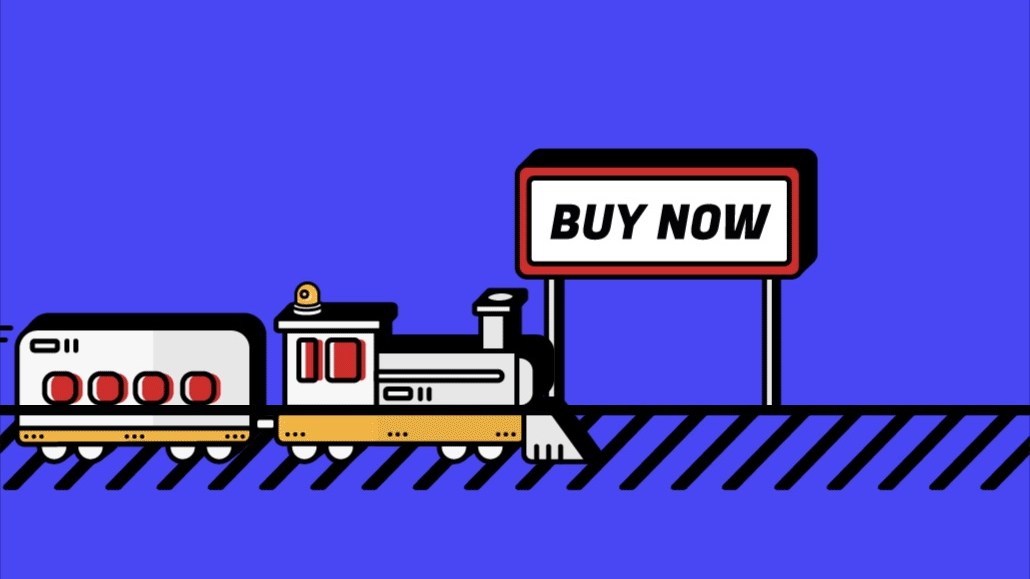Why OOH advertising is becoming a bigger part of this baby care brand’s marketing strategy

Babycare brand Coterie has rolled out its first out-of-home campaign, looking to get in front of parents and families venturing back outside now that Covid-19 restrictions have been lifted. Coterie is one of many brands leveraging OOH to diversify their media spend and capture the attention of shoppers out and about as Covid-19 precautions let up.
“It’s about building that iconic brand, lifting that brand awareness,” said Jess Jacobs, svp of brand and creative at Coterie, which makes diapers, pants and wipes. “We wanted something that would not just catch parents’ eyes but also that toddlers, children, and kind of anybody could interact with.”
Coterie isn’t alone. Brands like Sunday Scaries CBD, BelliWelli snacks and Titan investment app all launched OOH efforts this year. In fact, out-of-home advertising revenues hit $2.62 billion in Q2 of this year, on par with pre-pandemic record-highs of 2019, according to the Out of Home Advertising Association of America.
Earlier this summer, the New York City-based brand created a campaign around its new diaper product, dedicating 30% of the overall campaign budget to OOH for the first time ever, per Jacobs. Efforts included art installations around the city to catch the attention of parents with OOH partner Quan Media Group. Other OOH measures around that time included a billboard in SoHo, street-level posters and a food activation.
“We allocated 30% of our brand marketing budget for this specific campaign launch, which was a valuable investment being the first OOH activation for the brand,” Jacobs said in an email. She added that Coterie’s marketing budget has more than doubled from last year to this year, though she did not provide specific figures.
So far this year, Coterie spent nearly $90,000 on advertising efforts outside of social media, up from the $35,000 spent the year prior, according to Kantar. (Kantar does not track social media spending.) Also this year, Coterie spent nearly $400,000 on Facebook and Instagram advertisements, significantly less than the $902,000 spent in 2021, according to Pathmatics.
Jacobs said there was notable website traffic after the launch of OOH efforts earlier this year, though she did not provide specific figures. Additional attention was brought to the brand with user-generated content as they passed by activations and posted pictures of them online, she said.
“With all of our placements, we were able to utilize mobile retargeting to reach that same demographic, reinforce the messages and see that brand lift over time,” Jacobs said. “It’s part of a larger strategy for us.”
Brand and company investment in OOH advertising is returning to pre-pandemic levels, according to industry experts, who say it’s likely to continue. Alejandro Clabiorne, evp and executive director of New York at Mediahub Worldwide said the agency’s clients have done the same with the addition of newcomers.
“As we now reach the endemic phase of COVID, we are seeing more clients that weren’t necessarily OOH advertisers before the pandemic, considering OOH,” Clabiorne said in an email to Digiday.
Because OOH formats are diverse, from location to digitization to measurement capabilities, “it can offer clients [an] opportunity to connect with their consumers across the funnel.” Meaning OOH can be a key part of a marketing strategy whether brands are looking to boost awareness or acquire new clients.
As the digital advertising landscape continues to become increasingly more expensive and crowded with advertisers, Stephanie Ehui, group connections director at TBWA\Chiat\Day, said OOH offers an alternative marketing solution.
“You cannot skip, hide or fast forward over OOH. With almost all other types of media today, users can choose to simply ignore a brand’s message,” Ehui said via email.
After its first run with OOH, Jacobs said the media channel will always be worth considering in future campaigns, especially as the brand continues to grow and scale. “In our quest to really build an iconic brand, we see OOH as being an important part of that,” Jacobs said.
More in Marketing

How brands shifted marketing and media strategies through year of tariffs
Marketers share how they navigated the maze of tariffs and regulatory changes this year.

Despite the hype, agentic AI isn’t ready to take the brand controls just yet
Despite agentic AI boosting content creation speed, human oversight remains critical due to concerns over hallucination, brand consistency.

Starbucks hires first-of-its-kind marketing role heading up fashion and beauty collabs
Neiv Toledano has joined Starbucks as its senior marketing manager of fashion and beauty.








